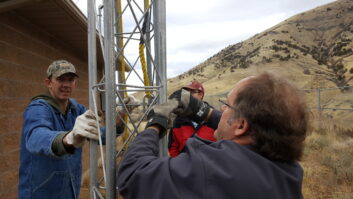JOHNSTON, IOWA�I recently fielded some questions from a colleague regarding the upcoming spectrum auction. The colleague observed that it appeared that the FCC was clearing the way for UHF stations that wanted to participate in the auction but still stay on the air to move to low-band VHF. He wanted to know what my feelings were on moving to low-band VHF and wondered if stations would really move there.
�
The decision on low-band VHF is really a business decision. I am a huge fan of over-the-air broadcasting and have that capability in my home. I travel with a USB tuner stick that lets me look at DTV services when I am on the road. But even I recognize that the majority of people that watch OTA broadcasts do it via a subscription-based service; thus they are not receiving the over-the-air services but a redistribution of which, in many instances, is provided via a direct feed from the stations’ studio rather than receiving the over-the-air signal.
�

In my opinion, low-band VHF is what I would call a “technological cul-de-sac.” It was a great technology in the early days of broadcasting when making power was an expensive proposition and generating RF at frequencies above 100 MHz was a challenge to do and keep stable, and receive antennas were mounted on the outside of homes high above the roof. Low-band VHF offered great �bang for the buck� for economical operation and the signals traveled considerable distances, even over the horizon. There were few television stations and few man-made noise sources to disrupt the service and when problems happened they were pretty easy to diagnose and correct. When I worked for WSAZ (channel 3) in Huntington, W.A., I frequently found power poles with dirty insulators using just my Sony Watchman as a locator and calling the power company to report down to the pole number the insulators that needed to be cleaned in a rural area.
�
NOISIER ENVIRONMENTS
Now the entire environment has changed. The number of stations increased to the point where the ability of low VHF strength to travel great distances has become its weakness because of interference, resulting in power levels being reduced to the point of absurdity. The man-made noise environment has swelled to the point where the issues for reception may not be a just a power pole in the area but with the hundreds, if not thousands of other man-made noise generators that raise the noise floor while the interference protection requirement lowers the signal level. Antennas are no longer on roofs but at best in an attic, but more frequently sitting on a table inside the house near the television creating the necessity for the diminished low VHF signal to overcome the increased noise level as well as endure the added loss of building penetration and complex echo environment within the home. In my opinion, the time for low-band VHF technology for television broadcast has passed and if the decision were to be based on technical criteria only, it is an easy decision to make.
�
But as I said before, it is a business decision. If the majority of the viewers are relying on a subscription-based delivery mechanism, there are compelling reasons to consider low-band VHF; cost of operation certainly being one. I recently did some computer modeling for a UHF station that is considering moving to low-band VHF as one possible scenario. Using their existing tower location, antenna elevation and the FCC’s methods for replicating coverage, their effective radiated power went from 85,000 watts down to 360 watts. Assuming they use a reasonable VHF transmitting antenna with a gain of 4 and allowing for losses through the passive RF system, their transmitter is in the neighborhood of 100 watts of DTV power; so the transmitter would consume less energy than most microwave ovens.�
�
Couple that with all of the specialized HVAC and associated requirements at a traditional transmitter site that is no longer required and the cost of operation would become inconsequential compared to the UHF costs. So for the cost of operation of a few household appliances this UHF station would be able to replicate its coverage and maintain its carriage rights within the same service area. Add to that the FCC�through the spectrum auction�may compensate stations for a significant percentage of the value associated with the UHF spectrum they are vacating in favor of the less desirable low-band VHF and from the business perspective, this could be quite attractive.
�
BUT THEN THERE�S 3.0�
Now of course what the station is sacrificing is reliable OTA indoor reception and future reception on portable devices which is one of the key benefits that the ATSC 3.0 proponents are working towards. I am also a big fan of ATSC 3.0 and the capabilities that it promises but until it is deployed, all of its benefits are theoretical in the eyes of the marketplace. And if it isn’t widely adopted by broadcasters and consumers, it is a great idea whose time did not come. So going back to my original business decision, if I believe that my business is to provide a few real-time streaming services�as is the traditional digital broadcast model�then moving to low-band VHF lets me stay in the business that I am already in, significantly reduce my costs of operation, and may provide a significant infusion of cash to help sustain the business from auction proceeds.�
�

On the other hand, if I believe my business has to change and adapt to the new audience behavior patterns, I have to recognize that the audience is mobile and wants the capacity for various levels of interactivity and additional capabilities over and above streaming. In that case, the business decision would be to stay with the UHF spectrum and plan for the adoption of ATSC 3.0. I would not make decisions that would preclude the business from succeeding with the changing audiences or limit my availability based on the already well-known and well-understood limitation of low-band VHF.
�
�
This article originally appeared in Radio sister publication, TV Technology.�
�







